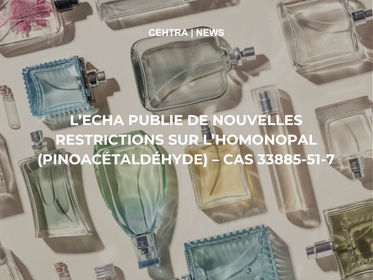top of page
Regulatory news and experts insights.
Stay updated with the latest developments, guidance, and resources in chemical regulations.
Search


Glabridine: An Ingredient Under Scrutiny in Cosmetics
Glabridine is an isoflavonoid (isoflavane) extracted from Glycyrrhiza glabra (licorice root). It is widely used in cosmetics for its skin-lightening and anti-tyrosinase activity, as well as for its antioxidant and anti-inflammatory properties. It is mainly found in skincare products, anti-aging creams, and sunscreens.
5 days ago1 min read


n-Hexane: An Omnipresent Solvent, Soon to Be Classified as a “Substance of Very High Concern”?
n-Hexane (CAS No. 110-54-3) is a volatile aliphatic hydrocarbon derived from petroleum distillation. Used as a solvent, it plays a key role in several sectors:
Food industry: extraction of vegetable oils (soy, rapeseed, sunflower), flavors, and proteins.
Cosmetics and perfumery: obtaining absolutes, essential oils, and pure plant extracts.
Its popularity is based on its efficiency, high yield, and low cost. However, this solvent requires strict purification to limit res
Sep 172 min read


Natural ingredients and food safety: myths, realities, and best practices
Lorsqu’on parle de nutrition, de compléments alimentaires ou d’ingrédients innovants, le mot “naturel” inspire immédiatement confiance. Mais est-ce qu’un ingrédient naturel est toujours sûr pour la consommation ?
Spoiler alert : pas nécessairement. Et c’est justement ce que les scientifiques et les experts en sécurité alimentaire s’attachent à démontrer, preuve à l’appui.
Sep 102 min read


ECHA Issues New Restrictions on HOMONOPAL (Pinoacetaldehyde) – CAS 33885-51-7
HOMONOPAL, également connu sous le nom de Pinoacétaldéhyde, est un aldéhyde aromatique synthétique couramment utilisé dans les compositions parfumées. Son numéro CAS est 33885-51-7. Reconnu pour son odeur verte, florale et légèrement aldéhydée, ce composé apporte de la fraîcheur et de la vivacité aux accords parfumés, en particulier dans les parfums de luxe, les produits de soin personnel et les formulations de nettoyage.
Aug 272 min read


Framework Guidance: Analysis of alternatives tobiocidal active substances
ECHA developed in 2022 a recommended (i.e. not mandatory) framework guidance to applicants for approval of biocidal active substances but also to Member State Competent Authorities (MSCAs) on how to perform an analysis of alternatives (AoA) to active substances being candidate for substitution (CfS) according to Art. 10(1) of the Biocidal Products Regulation ((EU) 528/2012). The guidance has been adopted at BPC-45 meeting and published in January 2023.
Mar 1, 20233 min read
bottom of page
